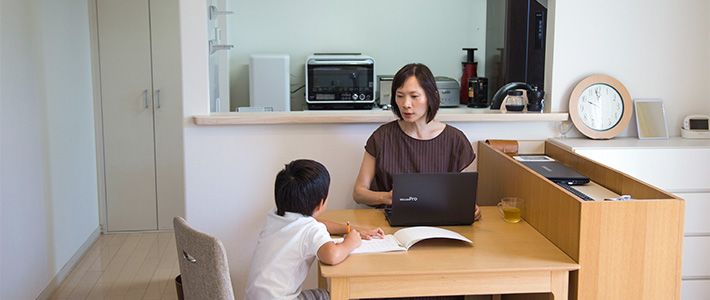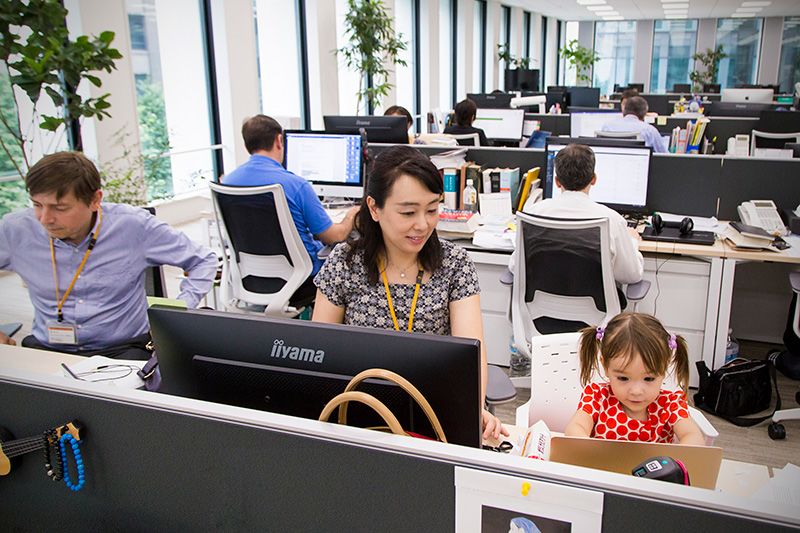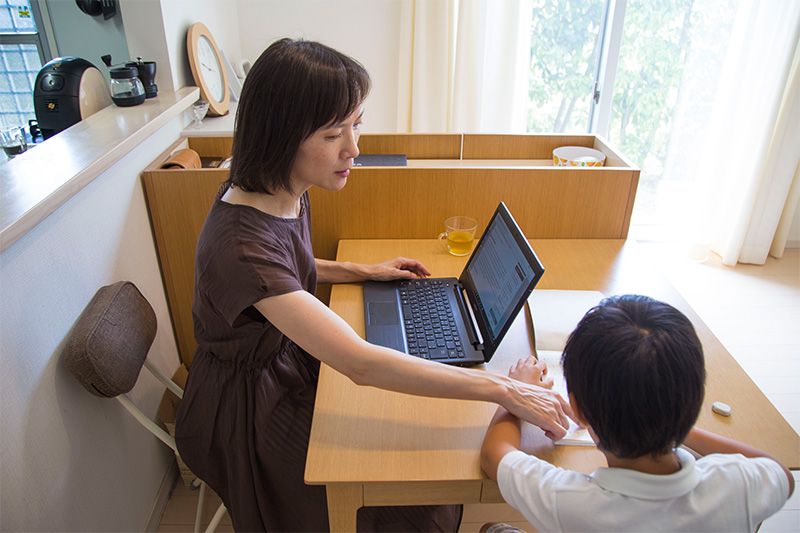
Reshaping the Japanese Workplace: Can “Work-Style Reform” Succeed?
Trying Out Teleworking at Nippon.com
Society- English
- 日本語
- 简体字
- 繁體字
- Français
- Español
- العربية
- Русский
On a July morning, Takagi Kyōko sits at her dining room table with a laptop issued by her employer, the Nippon Communications Foundation. Her first-grade son has just started summer break and is playing on the floor of the adjoining living room. “It really helps that I don’t need someone to look after him, even during vacations,” she says.
Takagi started working on Nippon.com in 2013, and is now in her fifth year at the foundation producing the site. As a member of the English-language team, she contributes mainly to the process of translating Japanese articles into English.
The first stage is to assign an article to a translator. When the completed English text arrives, she checks it for such problems as untranslated sections or factual errors. She is then responsible for ensuring it is ready to be published online, working together with the translator, editor, and web publishing team. She usually handles around 10 articles simultaneously.
A Well-Balanced Work Routine
Takagi works from home two days a week, avoiding the stress of commuting and using that time for work instead of riding trains.
On a typical day, she begins work at half past seven after sending her son off to school. Around noon, she takes a 90-minute break, which includes time for preparing the evening meal. Then she works until the evening, with another 30-minute break when her son comes home about four.
“On home days, I don’t have to deal with extra office duties like answering the telephone. So I save the work where I really need to focus for these days.”
Meanwhile, she performs duties best suited to the office on days when she commutes. These include discussing translation issues directly with translators and collaborating on the selection of photographs to illustrate articles. These tasks can be done by email, Skype, or telephone, but it is far more efficient to take care of them in person. The English-language team meeting is also held on days when she is in the office.
 Employer-issued equipment goes home with her, letting her seamlessly use the same computing environment.
Employer-issued equipment goes home with her, letting her seamlessly use the same computing environment.
In this way, Takagi maintains a well-balanced work routine, made possible by a laptop and mobile Wi-Fi router borrowed from the company. She is able to access the workplace server and clock in and out remotely. She says the server access is most useful in performing her duties as usual.
Supporting Workers with Children
Takagi is one of three female employees at the company who work remotely for part of each week. Nippon.com introduced the system based on the personal experience of Tani Sadafumi, who was appointed to the position of executive director in April 2016.
Tani’s daughter balances working in Singapore with raising her young child, who is now four years old. Seeing the difficulties she faced during a visit, he thought about how he could make life easier for those in a similar position.
Soon after arriving at the foundation, Tani held individual interviews with the 30 or so employees. His aim was to check if there was any ongoing situation that might make it difficult for them to continue working. Privacy considerations meant that there was no obligation to reply, but several employees did express concerns over their personal or family situations.
One employee, for example, had been unable to look after a sick child because of a job that needed to be completed. This meant hiring a babysitter for a number of days, which had eaten greatly into the employee’s monthly earnings.
An Early Start
Tani decided that a new system would increase motivation. He spoke to the heads of each department, who would take on the fresh duties of monitoring employees working remotely, but found them understanding, as they faced their own issues of balancing job duties with home tasks.
 Takagi (center) takes part in a meeting.
Takagi (center) takes part in a meeting.
Tani moved swiftly to improve conditions for employees in need of flexible work patterns. Before plotting out what exactly the new system would be, updating the organization’s regulations, and working through the other necessary processes, he gave discretionary approval to the two employees with preschool children to work from home. This was in May, the month following the initial interviews.
Teleworking became fully official in December. As Takagi’s son would soon enter first grade, the conditions for working from home were expanded to cover parents with elementary-school children.
More Time Together
“Without this system, I might not have been able to continue working,” Takagi said. She had been able to manage when her son was still enrolled in a nursery program offering longer hours of care. However, she had long worried about what she would do when he was in elementary school and finished lessons in the early afternoon.
Takagi’s relationship with her son and his well-being were other key concerns for her. When she went to pick him up from the nursery at seven in the evening, the other children had long returned home, and he was left alone waiting for her. Seeing him crying, she blamed herself for spending time at work. She thought about quitting her job and finding part-time work in her local neighborhood—a step that would have meant walking away from a workplace giving her the chance to exercise her language talents and experience to the fullest.
Now that her son is in elementary school, she balances her job and family life by working remotely part of the week. On days when she heads in to the office, she makes use of paid domestic services for additional support.
She is particularly happy that now she can spend more time with her son. Although she cannot play with him while she is working, she is present when he comes home from school, and they can have dinner together as soon as she punches the virtual clock.
“The company has told me not to hesitate to make use of the system. I feel a new sense of belonging now and I’m inspired to pay back this consideration through my work.” Teleworking does have some drawbacks, as issues that could be solved immediately face to face in the office often must be postponed until her next commuting day. But Takagi manages her schedule and work priorities to minimize inconvenience for her colleagues.
Take Your Daughter to Work
Inubushi Yōko, who has a preschool-age daughter, is another employee who makes use of the teleworking system. She checks and prepares Russian-language translations for publication as part of the multilingual department. She works from home for around half of each week.
After she gave birth, Inubushi worked full time for a period, dropping off her daughter at the nursery in the early morning. During this time she was only able to share one or two waking hours with her child each day. Now that she is working from home, though, she revels in the additional time she has with her family. She notes that her worries about a lack of quality time with her daughter have been considerably lessened by the teleworking system.
 Inubushi with her daughter in the office.
Inubushi with her daughter in the office.
When she is at home, Inubushi works for a short time in the early morning before her daughter wakes up, and then later on while she is at the nursery. When she is not working, she can spend the rest of the day with her daughter. In the evenings, they might go shopping together, go to the neighborhood park, or do some gardening. They can also visit her parents, who live nearby, or take a leisurely bath. “Life is like a dream now,” she says.
With the understanding of the foundation, she has also brought her daughter to work three times. The girl’s insistence on “going to work with Mommy” led Inubushi to reluctantly take her on a trial run in March. After the girl peacefully spent around two hours reading in the office, she and her mother caught the train home. Inubushi found herself surprised by the expression on the girl’s face. “I’d never seen her so filled with life and a sense of accomplishment.”
Inubushi’s fears that her daughter would create a disturbance had distracted her a little from her work, but she saw what a big event the visit to the office had been for the youngster.
Positives for the Organization
Inubushi feels strongly that she is supported as a mother in the workplace. “I want to increase productivity and apply my knowledge and skills to maximize my efficiency. I also want to get good results at work to give something back.”
Several months have now passed since teleworking was officially introduced, and Tani feels that it has been effective, thanks mainly to the satisfied reaction of the workers. He can now consider expanding the system to allow for nursing elderly relatives, as well as for use when a natural disaster or other circumstances make remote work desirable. “There are many positives for the organization,” Tani says, noting that the foundation is ready to try out still more flexible workplace policies.
(Originally published in Japanese on August 1, 2017. Photographs by Ōtani Kiyohide and Hashino Yukinori of Nippon.com.)